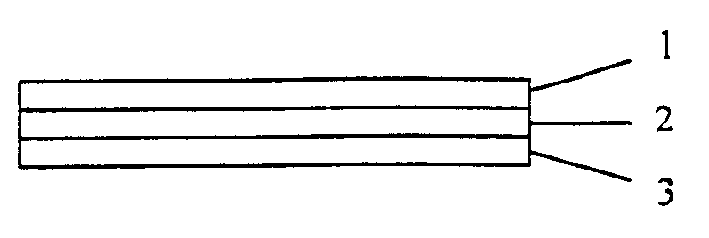Protein chip for covalent fixing biomolecular and its preparation method
A protein chip and biomolecule technology, applied in the field of protein chips for biological detection, can solve the problems of false positives, loss of biological activity, poor stability of ligand molecules, etc., to avoid false positive detection results, inhibit physical adsorption, and be less prone to denaturation loss. live effect
- Summary
- Abstract
- Description
- Claims
- Application Information
AI Technical Summary
Problems solved by technology
Method used
Image
Examples
Embodiment 1
[0031] according to figure 1 Preparation of a protein chip for detection of human immunoglobulin G (IgG).
[0032] The solid substrate 1 of the chip is a 0.5mm polished silicon wafer. The modified layer 2 is composed of chlorosilane polyethylene glycol derivatives, which are respectively Cl(CH 3 ) 2 Si(CH 2 ) 11 (OCH 2 CH 2 ) 3 OCH 2 COOCH 2 CH 3 and Cl(CH 3 ) 2 Si(CH 2 ) 11 (OCH 2 CH 2 ) 3 OCH 2 CH 3 , Made by mixing 1:50 (molar ratio). The ligand molecule is an antibody (antiIgG) to human immunoglobulin G (IgG).
[0033] The preparation of the protein chip is carried out as follows:
[0034] 1. Cleaning treatment of silicon wafer surface
[0035] Clean the surface of the silicon wafer with a weak alkaline solution (such as ammonia water) to remove surface stains.
[0036] 2. Hydrophilic treatment of silicon wafer surface
[0037] Put the silicon chip processed in step 1 into 30wt% H with a volume ratio of 1:3 2 o 2 and 98 wt% H 2 SO 4 soaked in th...
Embodiment 2
[0045] Preparation of protein chip for detection of human insulin (insulin).
[0046] The solid substrate of the chip is a 0.5mm polished silicon wafer, and the surface is a naturally generated silicon dioxide film. The derivatives of polyethylene glycol are respectively Cl 2 CH 3 Si(CH 2 ) 9 (OCH 2 CH 2 ) 4 OCH 2 COOCH 2 CH 3 and Cl 2 CH 3 Si(CH 2 ) 9 (OCH 2 CH 2 ) 3 OCH 3 . Ligand molecules are insulin antibodies (anti-insulin).
[0047] The preparation of the protein chip is carried out as follows:
[0048] 1. Cleaning treatment of silicon wafer surface
[0049] Clean the surface of the silicon wafer with a weak alkaline solution (such as ammonia water) to remove surface stains.
[0050] 2. Hydrophilic treatment of silicon wafer surface
[0051] Put the silicon chip processed in step 1 into 30wt% H with a volume ratio of 1:3 2 o 2 and 98 wt% H 2 SO 4 Soak in the mixed solution for 30 minutes, take it out and wash it with deionized water until neutr...
Embodiment 3
[0058] Preparation of protein chip for detection of interleukin 6 (IL-6). The solid substrate of the chip is a 0.5mm polished glass sheet. The derivatives of polyethylene glycol are respectively Cl 3 Si(CH 2 ) 12 (OCH 2 CH 2 ) 5 ONH 4 and Cl 3 Si(CH 2 ) 12 (OCH 2 CH 2 ) 3 OCH 3 . The ligand molecule is the receptor (IL-6R) for interleukin 6 (IL-6).
[0059] The preparation of the protein chip is carried out as follows:
[0060] 1. Cleaning treatment of glass surface
[0061] Clean the glass surface with a weak alkaline solution (such as ammonia) to remove surface stains.
[0062] 2. Hydrophilic treatment of glass surface
[0063] Put the glass treated in step 1 into 30wt% H with a volume ratio of 1:3 2 o 2 and 98 wt% H 2 SO 4 Soak in the mixed solution for 20 minutes, take it out and wash it with deionized water until neutral, and obtain a hydrophilic substrate with hydroxyl groups on the surface.
[0064] 3. Preparation of chlorosilane polyethylene glyc...
PUM
 Login to View More
Login to View More Abstract
Description
Claims
Application Information
 Login to View More
Login to View More - R&D
- Intellectual Property
- Life Sciences
- Materials
- Tech Scout
- Unparalleled Data Quality
- Higher Quality Content
- 60% Fewer Hallucinations
Browse by: Latest US Patents, China's latest patents, Technical Efficacy Thesaurus, Application Domain, Technology Topic, Popular Technical Reports.
© 2025 PatSnap. All rights reserved.Legal|Privacy policy|Modern Slavery Act Transparency Statement|Sitemap|About US| Contact US: help@patsnap.com


